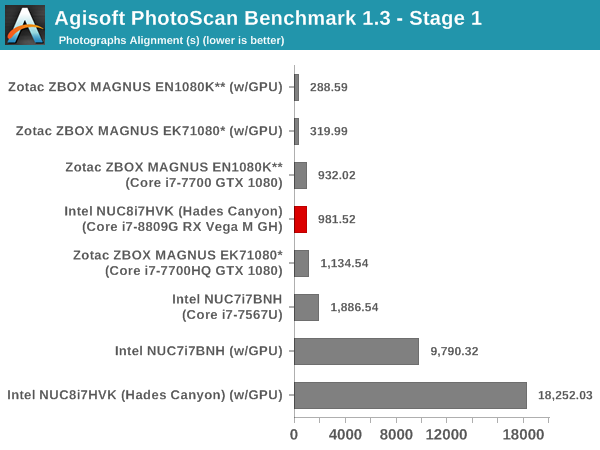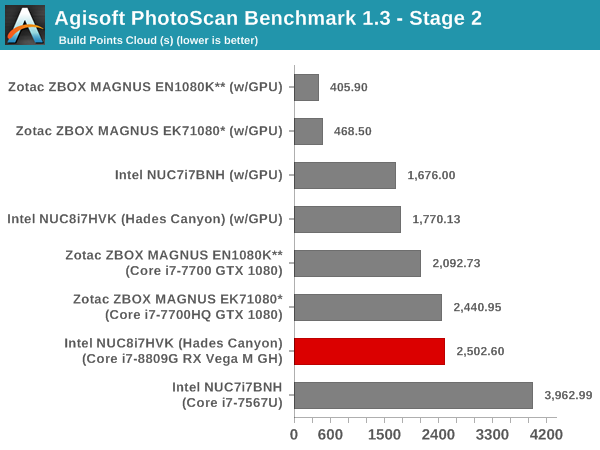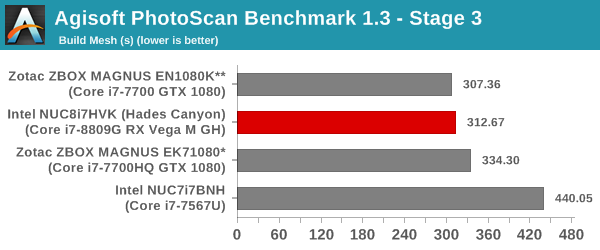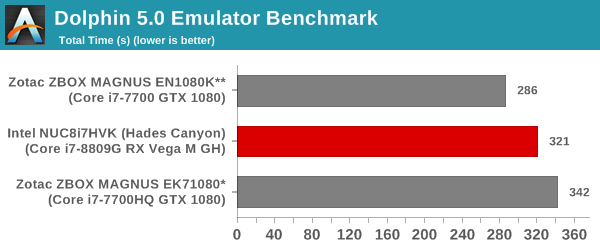The Intel NUC8i7HVK (Hades Canyon) Review: Kaby Lake-G Benchmarked
by Ganesh T S on March 29, 2018 1:00 PM ESTPerformance Metrics - II
In this section, we mainly look at benchmark modes in programs used on a day-to-day basis, i.e, application performance and not synthetic workloads.
x264 Benchmark
First off, we have some video encoding benchmarks courtesy of x264 HD Benchmark v5.0. This is simply a test of CPU performance. As expected, the Core i7-8809G with its 65W processor TDP slots closer to the Core i7-6700 and the Core i7-7700. Recent releases of the x264 benchmark can show even more impressive gains, as they make use of the latest and greatest features of the modern Intel processors.


7-Zip
7-Zip is a very effective and efficient compression program, often beating out OpenCL accelerated commercial programs in benchmarks even while using just the CPU power. 7-Zip has a benchmarking program that provides tons of details regarding the underlying CPU's efficiency. In this subsection, we are interested in the compression and decompression MIPS ratings when utilizing all the available threads. The performance order is similar to the one encountered in the x264 benchmark.


TrueCrypt
As businesses (and even home consumers) become more security conscious, the importance of encryption can't be overstated. CPUs supporting the AES-NI instruction for accelerating the encryption and decryption processes have become more widespread over the last few years. TrueCrypt, a popular open-source disk encryption program can take advantage of the AES-NI capabilities. The TrueCrypt internal benchmark provides some interesting cryptography-related numbers to ponder. In the graph below, we can get an idea of how fast a TrueCrypt volume would behave in the Intel NUC8i7HVK (Hades Canyon) and how it would compare with other select PCs. This is a purely CPU feature / clock speed based test.

Agisoft Photoscan
Agisoft PhotoScan is a commercial program that converts 2D images into 3D point maps, meshes and textures. The program designers sent us a command line version in order to evaluate the efficiency of various systems that go under our review scanner. The command line version has two benchmark modes, one using the CPU and the other using both the CPU and GPU (via OpenCL). We have been using an old version of the program with 50 photogaphs in our reviews till now. The updated benchmark (v1.3) now takes around 84 photographs and does four stages of computation:
- Stage 1: Align Photographs (capable of OpenCL acceleration)
- Stage 2: Build Point Cloud (capable of OpenCL acceleration)
- Stage 3: Build Mesh
- Stage 4: Build Textures
We record the time taken for each stage. Since various elements of the software are single threaded, others multithreaded, and some use GPUs, it is interesting to record the effects of CPU generations, speeds, number of cores, DRAM parameters and the GPU using this software.
The GPU-enabled numbers for Stage 1 and 2 below are with the use of the Intel HD Graphics 630, since our benchmark version only supports use of the first enumerated GPU. Unfortunately, when we tried to disable the integrated GPU and use only the discrete GPU after changing the BIOS setting, the benchmark consistently crashed while starting the first stage itself.




Dolphin Emulator
Wrapping up our application benchmark numbers is the new Dolphin Emulator (v5) benchmark mode results. This is again a test of the CPU capabilities, and the Core i7-8809G slots inbetween the 45W TDP Core i7-7700HQ and the 65W Core i7-7700.











124 Comments
View All Comments
vanilla_gorilla - Thursday, March 29, 2018 - link
> The NUC8i7HVK hits the ball out of the park on a number of fronts.I'm confused. I was just recently informed you were clearly a shill for AMD. What's going on here?
Kidding! Kidding! Another great review.
peevee - Thursday, March 29, 2018 - link
Why 230W powerbrick if the CPU+GPU are only 100W?Can it power an external thunderbolt display by USB power?
ganeshts - Thursday, March 29, 2018 - link
We see the system reach 230W under Prime95 + FurMark. I am checking with Intel on the exact reason for that, given no USB peripherals were connected.Each Thunderbolt 3 port can provide 15W. The rest depends on the specifications of the Thunderbolt display you are talking about - to the best of my knowledge no USB-powered *Thunderbolt* display exists.
Hixbot - Saturday, March 31, 2018 - link
Wow, they got some splaining to do.The_Assimilator - Monday, April 2, 2018 - link
Not much to explain - everyone knows Vega is a power hog.GreenReaper - Sunday, April 1, 2018 - link
Most CPUs and GPUs are specced for instantaneous and even reasonably long-term power draw in excess of their TDP, which is more of a long-term cooling target (hence the *thermal* design part of the acronym). Then you have to supply power to ports, RAM, SSDs, etc. It all adds up fast. This is also one reason laptop tend to lack large numbers of high-powered USB/Thunderbolt ports.Samastrike - Thursday, March 29, 2018 - link
So routing display outputs through the AMD graphics was a choice by Intel for this specific machine? Hopefully Dell and other manufacturers won't do the same in laptops like the XPS 15 2-in-1, it would be crazy to cut off access to Intel's decode blocks for things like Youtube in a laptop.sharath.naik - Thursday, March 29, 2018 - link
This is too expensive. The Dell 7000 gaming laptop is closer to 1000$ (gtx1060) and will do better in all the games. I cannot think of one reason to by this NUC over the laptop. This NUC should have been priced at ~600$ barebonesCrazyeyeskillah - Thursday, March 29, 2018 - link
This review is for the $1700 NUC. Clearly not designed for the gaming market whatsoever. a 700 laptop could rip this to pieces.Cooe - Friday, March 30, 2018 - link
The only reason this particular SKU is so expensive is the Optane SSD + a NAND SSD too. Normally, this would be around $1200-1300 fully kitted.